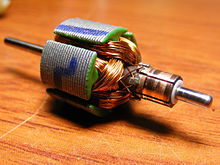Permanent magnet motor
The permanent magnet motors (IP) are electric motors whose operation is based on permanent magnets. There are several types, the best known being:
- Continuous IP current engines
- Alternate IP current motors
- Step by Step IP Motors
One of the most widely applied is the permanent magnet synchronous motor (in English Permanent Magnet Synchronous Motor, PMSM).
Permanent Magnet Synchronous Motor
Permanent magnet motors are extensively used in servo motors, electric drives for positioning, robotics, machine tools, elevators, etc. Machines with a power of over 1 MW have been built, for example, to drive submarines. Its application in generation and pumping from photovoltaic solar energy or wind energy is also possible. More recently they are used in the propulsion of high-speed trains and, generally, it is the type of motor used in electric vehicles.
The construction of the rotors of the permanent magnet synchronous servo motors can adopt a cylindrical shape with a low diameter and a long length (cylinder rotor) called radial flux, or they can have a more disc-shaped rotor. lightweight disk rotor (disk rotor), also called axial flux machines, thus resulting in both a low moment of inertia and a low mechanical time constant. On the other hand, for industrial applications with line start or by means of reduced voltage starters, the motors have a damper that protects the magnets from demagnetization during the transients associated with starting, and also dampens pendulum oscillations.
These motors have a slight axial play which allows to establish the fixed loads of movement.
In applications where the motor is electronically operated from an inverter, the damper winding is not necessary for starting as it is performed by the electronic control, and also the damper winding (damper) produces additional energy losses due to non-current waveforms. sinusoidal
The case of a three-phase stator will be analyzed, which is similar to one of a classic three-phase synchronous machine, highlighting two types of PMSM depending on the type of rotor:
- magnets mounted on the rotor surface (Surface-mounted magnets)
- magnets inserted in the rotor (Buried Magnets)
PMSM with magnets mounted on the rotor surface
In the event that the magnets are mounted (glued or strapped) on the surface of the rotor, due to the space they occupy, they require a relatively large air gap, and ceramic magnets have negligible saliency effects. In these cases there is no damper winding. The large air gap causes the armature reaction (RA) flux to have attenuated effects on the rotor, that is, the synchronous inductance Ld is small since it has a small armature reaction component Lad and therefore the effects of RA are very dimmed. On the other hand it follows that the large air gap results in a small electrical time constant of the stator T = L/R.........
PMSM with magnets inserted in the rotor
If the magnets are inserted in the rotor, they are physically contained and protected, but the iron space removed from the rotor to insert the magnets means that in this case it cannot be considered that there is a uniform air gap, there is a saliency, and a reluctance component of the torque appears.
The design criteria in the case of servomotors must meet the following requirements:
- Operating speed and par controlled at all speeds
- High relationship [Power / weight] and [Par / inertia]
- Soft electromagnetic pair: better control of the harmonics which decreases torque pulses
- High flow density in the interhero
- Compact design with high performance and power factor.
Contenido relacionado
Beta decay
Cosmic inflation
Modulated amplitude
